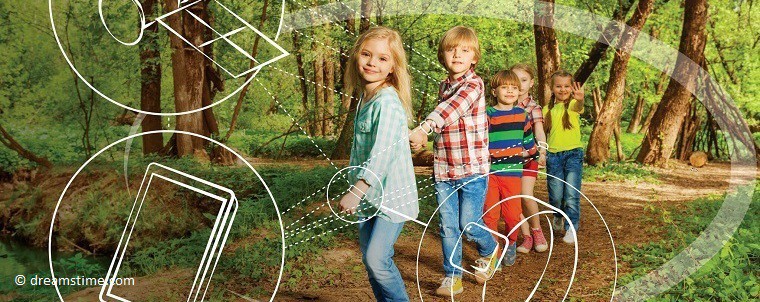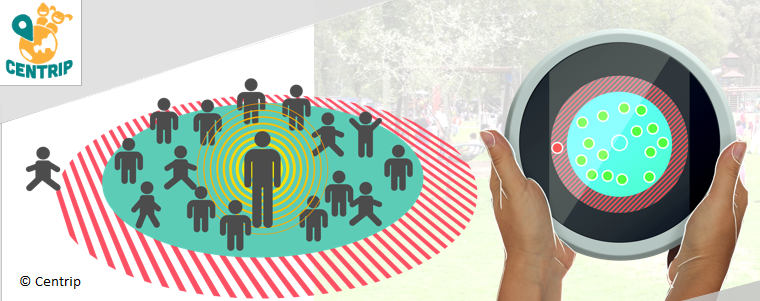By combining GNSS and ZigBee technologies, CENTRIP (ChildrEN TRIp Protector) – the winner of the ESNC GSA Special Prize 2017 – developed a product that contributes to the safety of children during their outdoor activities when they are not being supervised by their parents. Teachers, group supervisors and children use the devices to locate their exact position and to be notified when they exceed a maximum distance from the receiver.
Centrip is currently developing its project further in the ESA BIC Noordwijk. In 2017, Centrip won the E-GNSS Accelerator Bootcamp and thereby has profited from EUR 62,000 incubation and acceleration services for its business. AZO Project Manager Luisa Wagner (LW) interviews Ewa Kadziolka (EK), Founder & CEO at Centrip.
LW: Please give us a sneak peek of your product and the team behind it.
EK: Centrip is a satellite navigation-based system to control and manage groups, which assists teachers in keeping children safe during school trips. It reduces the risk of incidents whilst allowing children to discover the world outside kindergartens and schools.
Kids are very easily distracted. When they see something interesting, they quickly lose focus, which can obviously lead to big problems. To prevent this, we’re using GNSS and another, supporting system to calculate distances between the group members and notify the teacher in the event that a child wanders off. The system is designed to work outdoors and indoors (including underground), meaning it can be used in all learning environments.

The world around us is changing, we’re introducing technology to all parts of our lives to make things easier and better. And, even though there is no substitute for people, we can certainly support them during excursions, enhance senses and therefore ensure safety, even in high-pressure situations.
LW: What was your team’s biggest challenge so far?
EK: We are still at an early stage so everything is both a challenge and an opportunity. For now, we need to confirm that the technology performs well. Since we are using GNSS as a basis, we have to make sure the signal quality is always good enough and develop a strong backup in case it is not. Precision is critical to the system’s usability and that’s what we’re focusing on most now.
Therefore, the first big challenge was prototype development and verification that everything works. There are still a few things to tackle and many challenges ahead, but we can’t wait to solve every single one of them and deliver a great product.
LW: Can you explain the three main ingredients of your recipe for success?
EK: Perhaps courage, belief and cooperation. There are a lot of people with ideas out there but there are very few who decide to act on it. It’s not always going to be easy, but if you really believe that your product is great and can make a positive change, now is the best time to do it. There is always the question of “how”, but there are people here to help and support you- so I guess an objective sense of trust and an ability to listen would have to be added to the list. Take notice of what the clients, interested parties or, in general, more experienced people have to say, and use it well.
LW: How did the ESNC and its network help you to kick-start your business case?
EK: If it wasn’t for ESNC, we basically wouldn’t exist yet. There are many existing companies participating who need support for specific projects but, in our case, this was really the breaking point; it not only convinced us that this is the right time but also, with the funding and support we received, it essentially gave us an opportunity to really get started. With the experience and knowledge of the ESA BIC Noordwijk where we are now, we’re learning a lot every day and benefit from its extensive network, access to ESA ESTEC, and mentoring.
LW: How and when did the idea for your application emerge?
EK: It all started on the ESA-JRC Summer School on GNSS in 2016. One part of it was a competition for innovative business ideas using GNSS. There was actually a kindergarten right next to the building where everything was happening; at some point, a group went for a walk and, even over that really short distance, there was already some distraction and confusion happening. It served as an inspiration and, eventually, the idea was formed. Centrip won that year, and we’ve been working on taking it to the next level ever since. That’s where it originated from, but the real beginning and key point was the ESNC and the success there.
LW: What convinced you to enter the GSA challenge with your business idea?
EK: The name of the GSA challenge that year was “60 years of EU: The most innovative application fostering European integration”, and we really believe we fit into this category very well. GSA is the main European Institution implementing the Galileo programme, so we saw a great benefit in being supported by them, in getting access to their exceptional partner network, and promotion through their channels and relevant events.
LW: Let’s reach for the stars – what is going to happen in your project’s future?
EK: Our journey is just starting now, there is still a lot to do. But the goal is to make Centrip a standard for group control. We are focusing on children now as we see it as an important topic, but the system is ready to work with other groups, too, and we’re going to explore it further when the right time comes. There is a lot of testing and certification still to come but, hopefully, the product will have its market entry as soon as in 2018!
Do you want to be just as successful as Ewa with her business case Centrip? Then use your opportunity, explore the ESNC and find the challenge that best suits your own idea!
Find out more about Centrip at their official website: www.centtrip.com/




